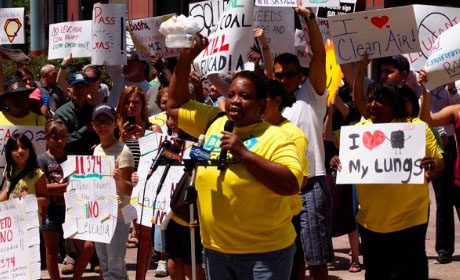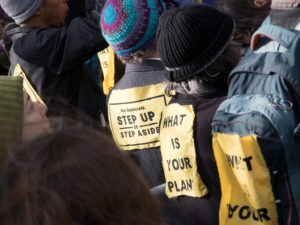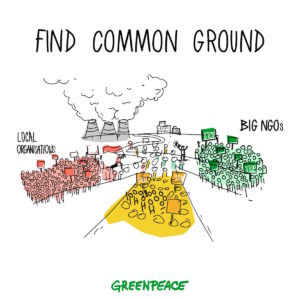When the campaign to end the world’s reliance on coal began 10 years ago, no one imagined what it might take to change what was clearly deeply entrenched political and financial support of the coal industry.
Rather, those who chose to engage in the movement assumed from the start it would be a long, if not life-long, process.
“The coal industry is well funded, aggressive, and controlled by politicians,” says Sierra Club national communications strategist Eitan Bencuya. “It is an entrenched player.
“We had to be creative with minimal resources. We had to use people power.”
This approach, which focused on coalition building and key messaging, has successfully resulted in Beyond Coal celebrating the half-way point of its campaign in the U.S. after American Electric Power said it would retire three coal plants several months ago.
The campaign also received a major boost in 2011 when New York City Mayor Michael R. Bloomberg provided a $50 million grant to support moving beyond coal.
In total, 165 new coal-fired power plants have been stopped in their tracks. The campaign has helped retire more than 100 coal-burning power plants, and dried the river of mountaintop-removal mining that paved the way for coal-fired plants.
Today, the Beyond Coal campaign is working on securing commitments from remaining coal plants, including those operated by colleges and universities.
It’s also collaborating on clean energy solutions with the successful launch of Antelope Valley Solar Farm, one of the largest new solar farms in the U.S.
MobLab recently caught up with several Sierra Club campaigners to learn more about the key components that’s enabling them to win against the deep pockets and politically-networked coal industry.
Coal Collaborators Expand Messaging
The Sierra Club has been working with allies to spread the coal message beyond an environmental network including the American Lung Association, Greenpeace, and Earth Justice.
Linking the Beyond Coal campaign to health messaging was a major factor in the campaign, Eitan says.
“Coal makes people sick,” he says, telling a story of a family who live in the shadow of a coal plant in Detroit.
“Every kid in that family has asthma,” he says. “The reality is very stark.”
“You have mercury in fish, kids with asthma, newborns and pregnant mothers who get ill. It’s easy to see we are cleaning energy for the people not just the climate.”
Key Takeaways:
- Connecting the campaign message with people’s health increases success. In this case, coal makes people sick. Convincing them of that, educating them about it, becomes part of the campaign strategy.
- Collaborating with other organizations that have aligned or relational key messages broadens the campaign and attracts new audiences.
- Strategically identifying leaders from grassroots activists helps broaden the network of campaign managers.
- Running simultaneous campaigns that offer alternatives brings momentum and direction to a campaign.
- A “bottom-up, top-down squeeze” technique spreads aligned messaging to key stakeholders in a co-ordinated communications strategy that proves more difficult to resist.
The power of the health messaging, much of which came from the American Lung Association, was essential, he says, in broadening the education of the public about more than the climate effects of coal.
The ALA continues to produce reports to support the Beyond Coal campaign. In March 2011, it released Toxic Air: The Case for Cleaning Up Coal-fired Power Plants, stating that “people living closest to these plants, especially children, seniors and those with chronic disease, face the greatest risk, but it doesn’t stop there. Pollution from coal-fired power plants takes flight and travels far into other states — threatening public health.”
Earth Justice also continues to message about the health effects of coal. It’s recent lead infographic, The Health Impacts of Coal Toxins, incorporates an interactive human body that clearly labels the risks and organs affected by the six main toxins, boron, mercury, chromium, selenium, lead and arsenic.
These organizations helped inform the public about the energy cycle — that energy doesn’t come magically when a switch is turned on, but that its life cycle incorporates a massive destructive process that includes ill health. Eitan says this is one of the biggest challenges of the campaign so far.
People Power
At the same time the campaign advocated for the end of coal and supported alternatives through education, political and grassroots campaigns, strategists with the campaign engaged hundreds of thousands of volunteers.
Online Beyond Coal manager for the western division Nathan Riding says a key to creating a large scale volunteer campaign such as this is to cast “a wide net.”
While casting the net, strategists diligently researched each community it targeted, searching for the stakeholders in that community to determine who are the people with the power.
“Part of success of the coal campaign is being very deliberate in that,” Nathan says.
Showing commitment to the community is also key to building trust, and success, he adds.
To achieve this, Sierra Club works to form coalitions with stakeholders in strategically-chosen communities.
At the same time, campaigners aimed to engage as many people as possible in low-level activities such as signing an online petition. Once they have engaged supporters at that level, they follow up in incremental steps.
“Maybe that same person who signed the petition will now write a letter to the editor,” Nathan says.
From there, the volunteer might lobby local politicians, and might be identified as a leader in a community, someone the higher level campaigners identify as a potential collaborator.
“We cultivate leadership,” he says, “people having significant input into how we run the campaign. In the end, we have a network of ‘super volunteers’ in neighbourhoods.”
That was the case in San Antonio, where local activists made the difference in having the city commit to shutting down its 900 megawatt Deely coal-fired power plant by 2018, and plan to replace the power with a combination of traditional sources like natural gas, renewable energy, including solar energy, and energy efficiency.
In the case of Beyond Coal, the grassroots movement kept on building and building, Nathan says, until organizers realized that they could “turn the tide on coal,” despite the behemoth it appeared to be.
Bottom-up, Top-down: The squeeze
A simultaneous squeeze from the bottom and the top is the way Beyond Coal organizers describe the structure of their campaign.
At the same time as grassroots volunteers are on the ground demonstrating, issuing health reports, showing up at meetings, putting pressure on mayors and doing other local work, a federal team of campaigners in
Washington D.C. and across the country is working to pressure the coal industry at large with a message that “coal is a bad investment and that Congress should pass legislation that holds polluters accountable.”
The messages of the “bottom” and “top” are aligned, strategically co-ordinated and carefully managed.
End of Coal?
Recent headlines demonstrate the power of the campaign: “Los Angeles’ ‘Coal Free’ Vow Scuttles Utah Power-Plant Expansion.” The story quotes the director of Sierra Club’s Beyond Coal campaign, Bruce Nilles.
“At the beginning of the coal rush in 2001, it seemed inevitable that as many as 150 new proposed coal plants would get built. Since then we’ve seen an incredible change in the way people, businesses and governments – like Los Angeles – are thinking about energy, figuring out how to generate and use it more cleanly and efficiently. Coal is no longer a smart or cost-effective option.”
As well, messaging about alternatives to coal is embedded in the campaign. Solar and wind energy are cleaner alternatives to coal. Despite pockets of resistance to these new forms of energy, Nathan says careful planning with the community ahead of a wind or solar farm such as Antelope Valley mitigates the naysayers. That includes making friends with conservation groups and other environmental and health advocates, to both educate them about solar or wind energy, and to mobilize them to support the community’s transition to clean energy.
According to the Sierra Club, the Beyond Coal campaign, in partnership with more than 100 organizations nationwide, is one of the most successful environmental campaigns in U.S. history.
The campaign currently employs more than 175 staff members around the country and has a plan in place to responsibly retire another 50,000 megawatts by 2020.
With more than one local action every day, the campaign is working to retire coal plants on all fronts — from public utility commission hearings, to legal actions over Clean Air Act violations, to investor meetings, to community actions — and averaged one coal plant retirement a week in 2012.
As of writing this article, there are 377 coal fire plants to go, a goal the campaigners plan to reach by 2030.
Stay connected: @LABeyondCoal @BeyondCoal @sierraclub
Related posts:
Facebook users convince Hungarian companies to wash GMOs from food supply
Missed calls help in campaign to protect Indian forests
Do you have an innovation in mobilisation or people-powered campaigns? Share it with Mob Lab by contacting MobLab@greenpeace.org.




